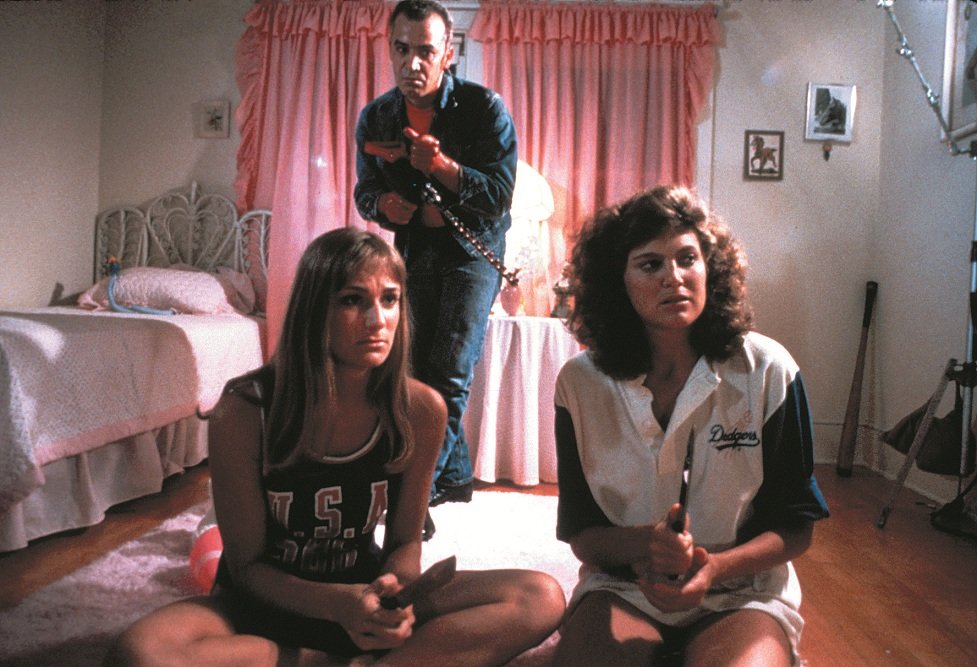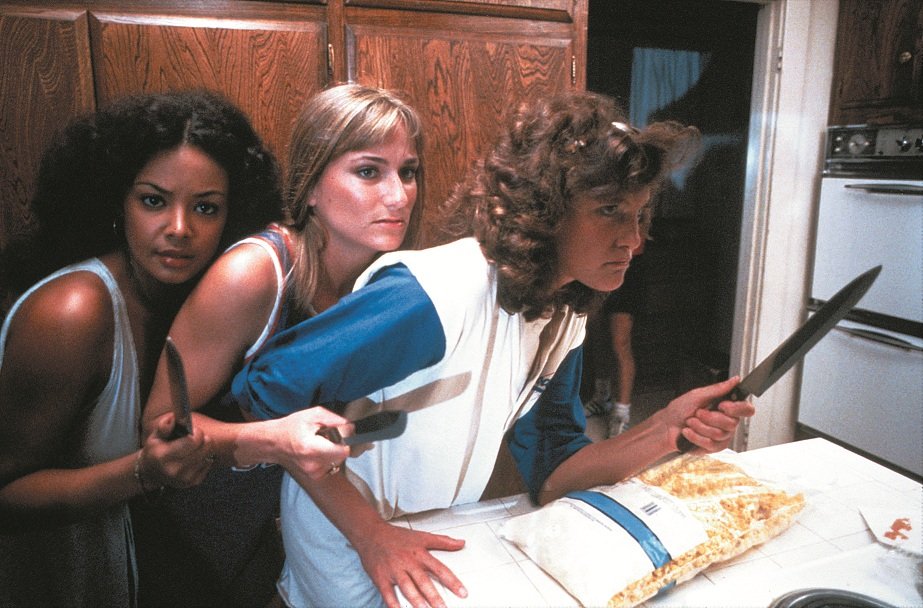SLUMBER PARTY MASSACRE: Stalking & Slashing From A Woman's Perspective
From the very beginning, slasher films were accused of being both anti-sex and anti-woman due to the fact that the victims were usually sexually-active females. Thus, it's no surprise that this subgenre didn't get much love from feminists or mainstream film critics. However, despite their linkage of sex and death, these films often had a "final girl" as the only person strong/smart enough to survive and defeat the usually-male villain. After time passed and the initial animus toward slasher films wore off, the "final girl" element has endeared certain slasher films to female horror fans in retrospect.A film that benefits from this post-modern perspective is Slumber Party Massacre. It was dismissed in its day as a threadbare slasher-clone and attracted a greater-than-usual level of critical negativity because it was written and directed by  women instead of the usual male filmmakers. However, it was successful enough to spawn two sequels (and several knockoffs). Better yet, it has achieved a cult following over the last few decades, partially due to the fact that the film and its sequels represent a rare beachhead for female filmmakers within the often male-centric horror genre.In classic New World Pictures style, the plot of Slumber Party Massacre is stripped to the bone. High-schooler Trish (Michelle Michaels) plans a slumber party when her parents leave town for the weekend and invites the rest of her cohorts on the basketball team. She wants to invite Val (Robin Stille) but the group's resident mean girl, Diane (Gina Hunter), puts the kibosh on it while Val is within earshot. However, there is even bigger potential drama in the offing: none of them knows that escaped mass-murderer Russ Thorn (Michael Villella) has decided to make the girls his next victim.
women instead of the usual male filmmakers. However, it was successful enough to spawn two sequels (and several knockoffs). Better yet, it has achieved a cult following over the last few decades, partially due to the fact that the film and its sequels represent a rare beachhead for female filmmakers within the often male-centric horror genre.In classic New World Pictures style, the plot of Slumber Party Massacre is stripped to the bone. High-schooler Trish (Michelle Michaels) plans a slumber party when her parents leave town for the weekend and invites the rest of her cohorts on the basketball team. She wants to invite Val (Robin Stille) but the group's resident mean girl, Diane (Gina Hunter), puts the kibosh on it while Val is within earshot. However, there is even bigger potential drama in the offing: none of them knows that escaped mass-murderer Russ Thorn (Michael Villella) has decided to make the girls his next victim. As the party begins, Russ begins picking off peripheral people - mostly men, surprisingly - with his trusty electric drill as he prepares for a mass-murder of the coeds. Their only hope for the partygoers lies in the neighbor across the street - the spurned Val, who is spending a night in with her little sis Courtney (Jennifer Meyers) while trying to pretend the rejection didn't bother her. When the killer attacks his favored prey, the survivors will have to overcome their differences to end his drill-swinging reign of bloodshed.It's no surprise that the end result was critically lambasted during its original release, as Slumber Party Massacre is very much a textbook example of a genre that critics (both genre and mainstream) detested. It's driven by its setpieces, with characterizations taking a backseat to the mechanics of suspense. Its major draw is pretty women, one of them s
As the party begins, Russ begins picking off peripheral people - mostly men, surprisingly - with his trusty electric drill as he prepares for a mass-murder of the coeds. Their only hope for the partygoers lies in the neighbor across the street - the spurned Val, who is spending a night in with her little sis Courtney (Jennifer Meyers) while trying to pretend the rejection didn't bother her. When the killer attacks his favored prey, the survivors will have to overcome their differences to end his drill-swinging reign of bloodshed.It's no surprise that the end result was critically lambasted during its original release, as Slumber Party Massacre is very much a textbook example of a genre that critics (both genre and mainstream) detested. It's driven by its setpieces, with characterizations taking a backseat to the mechanics of suspense. Its major draw is pretty women, one of them s exually active, who get attacked and killed. There's also some gratuitous nudity amid the bloodshed to up the overall commerciality of the package. The fact that women were involved in the writing and directing was like a red rag waved in front of a bull for the critics, particularly those of the feminist variety, who were disgusted at seeing women purveying the same kind of exploitative sex and violence that normally came from male filmmakers.However, Attacking Slumber Party Massacre for not being a feminist rewrite of genre misses the point because that's not what the film is trying to be. Instead, it sets out to deliver the slasher-flick goods while toying with its elements from within. If you look at the storyline closely, you'll notice that the film presents women confidently fulfilling traditional male roles (coach, electrician, maintenance person) and that the men in the film are ineffectual or, in the case of Russ Thorn, dysfunctional and insane.It's also worth noting that the majority of the onscreen violent deaths go to the male characters instead of the women (who are often dispatched quickly or die offscreen). Another amusing element is the requisite locker-room scene, which is directed in an over-the-top that directly satirizes the gratuitous nudity it is presenting (the best of both worlds!).
exually active, who get attacked and killed. There's also some gratuitous nudity amid the bloodshed to up the overall commerciality of the package. The fact that women were involved in the writing and directing was like a red rag waved in front of a bull for the critics, particularly those of the feminist variety, who were disgusted at seeing women purveying the same kind of exploitative sex and violence that normally came from male filmmakers.However, Attacking Slumber Party Massacre for not being a feminist rewrite of genre misses the point because that's not what the film is trying to be. Instead, it sets out to deliver the slasher-flick goods while toying with its elements from within. If you look at the storyline closely, you'll notice that the film presents women confidently fulfilling traditional male roles (coach, electrician, maintenance person) and that the men in the film are ineffectual or, in the case of Russ Thorn, dysfunctional and insane.It's also worth noting that the majority of the onscreen violent deaths go to the male characters instead of the women (who are often dispatched quickly or die offscreen). Another amusing element is the requisite locker-room scene, which is directed in an over-the-top that directly satirizes the gratuitous nudity it is presenting (the best of both worlds!). The film doesn't always live up to the cleverness of its setups due a lack of dramatic investment: the performances of the young female cast tend towards flatness because their characterizations are so thin. Stille and Meyers come off the best, partially because they have the best-written character scenes and partially because they have believable big sis/lil' sis chemistry. It's worth noting that Villella does impressive work at the villain, bringing a nice Method-style creepiness to an otherwise stock role (the one moment where he speaks is a skin-crawler). Also, some of Jones' attempts at overt humor come off as goofy (a famous bit involving pizza is funny but detracts from what is supposed to otherwise be a tense scene).That said, such flaws aren't difficult to endure because the film is such a lean and focused enterprise: it's 77 minutes with credits, ensuring there is a minimum of filler. Better yet, Jones handles the suspense stuff with amazing skill for a first-timer. There are several memorable and stylish setpieces that lean on her background as an editor, like a scene where the killer
The film doesn't always live up to the cleverness of its setups due a lack of dramatic investment: the performances of the young female cast tend towards flatness because their characterizations are so thin. Stille and Meyers come off the best, partially because they have the best-written character scenes and partially because they have believable big sis/lil' sis chemistry. It's worth noting that Villella does impressive work at the villain, bringing a nice Method-style creepiness to an otherwise stock role (the one moment where he speaks is a skin-crawler). Also, some of Jones' attempts at overt humor come off as goofy (a famous bit involving pizza is funny but detracts from what is supposed to otherwise be a tense scene).That said, such flaws aren't difficult to endure because the film is such a lean and focused enterprise: it's 77 minutes with credits, ensuring there is a minimum of filler. Better yet, Jones handles the suspense stuff with amazing skill for a first-timer. There are several memorable and stylish setpieces that lean on her background as an editor, like a scene where the killer  stalks future scream queen Brinke Stevens in an empty locker room. However, the best moment is the grim finale, which exploits castration anxiety in an amusingly symbolic way and ends with a haunting final succession of images. Ralph Jones' gothic-tinged synth score seals the deal, with its chilly sound sealing the vintage-slasher feel.To sum up, Slumber Party Massacre is a solid genre entry with enough unique elements to make it worth adding to the collection for slasher-flick enthusiasts. The female-centric elements don't necessarily define it but they give it enough an edge to help it stand out from its competitors.
stalks future scream queen Brinke Stevens in an empty locker room. However, the best moment is the grim finale, which exploits castration anxiety in an amusingly symbolic way and ends with a haunting final succession of images. Ralph Jones' gothic-tinged synth score seals the deal, with its chilly sound sealing the vintage-slasher feel.To sum up, Slumber Party Massacre is a solid genre entry with enough unique elements to make it worth adding to the collection for slasher-flick enthusiasts. The female-centric elements don't necessarily define it but they give it enough an edge to help it stand out from its competitors.


